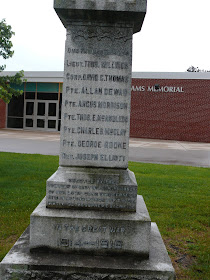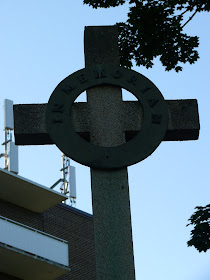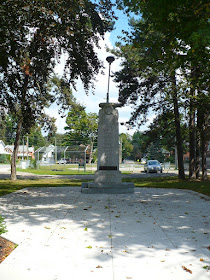 Location: United Counties of Stormont, Dundas and Glengarry
N 45 01.926 W 75 29.941
Location: United Counties of Stormont, Dundas and Glengarry
N 45 01.926 W 75 29.941
In Mountain Memorial Park, on the south side of Clark Road.

This memorial is dedicated to the Battle of Hill 70, one of the costliest and hardest fought battles the Canadians would face in WWI. It was the first battle which was led by Canadian command and remains one of the few battle honours which is only available to Canadian Regiments. This is the only memorial in Ontario dedicated solely to Hill 70, and today, August 19th, marks the 100th anniversary of that epic victory.
The memorial itself was first erected in 1922 and has since been added to, most notably in 2012 when it underwent a huge restoration and the addition of two black granite stones which tell the story of the Memorial Park and of the Battle of Hill 70. The descriptions on these stones best articulates the details, so I will let their words continue to tell the story. A German machine gun, captured at the battle is also part of the display.
A very fitting and fine memorial to the hundreds of soldiers who became casualties of this battle, and to those who carried on the good fight.


Marker text:
Centre stone:
HILL 70
Cote 70
Lest We Forget
Noublions Pas

Right flank stone:
1922

Left flank stone:
This park is a memorial to 8,677 Canadian casualties in
The Battle of Hill 70
World War 1
August 15 to 25, 1917
An overwhelming victory for the Canadian Corps


Mountain Park Stone:
Mountain Memorial
Community Park
A community meeting was held at Foster's Hall on May 22, 1922
to organize a committee to purchase a 22 acre parcel of land from
Charles Robinson for a park known as Mountain Memorial Community
Park.
The Trustee board consisted of 7 members- Sam Van Allen, Fred
Barrigar, Robert Bryan, J.R. McGillis, Dr. A. Hoy, Frank Milne and
Sam Workman.
A subscription canvas was conducted. Each donor was allowed one
vote for each $5 donated. Much hard work, time and energy was
given to the project in order to clear, level and seed the north half
of the park to make it a natural playground. The southern half was
left as a woodlot.
The Mountain Memorial Community Park was officially opened on
November 12, 1925 when Brigadier General S.W. Hill dedicated a
light as a permanent memorial to the memory of fallen heroesof
Mountain Township in the First World War. The light, erected on a
tall flagstaff, was installed on a hill designated as "Hill 70" and
constructed in the centre of the park. The electric current was kindly
donated by N.W. Beach. The hill commemorates the spot from
which General Sir Arthur Currie conducted his first major operation
as Commander-in-Chief of the Canadian Corps near Lens, France.
A captured German machine gun was also mounted on the hill
Over the years, neighbouring communities came to enjoy the many
recreational facilities provided at the park. Hockey matches were
played, skating was enjoyed to band music, carnivals were well-
supported, ball tournaments took place on the softball diamond,
picknickers came to pass a summer's afternoon walking along the
winding cindered path through the shady woods and emerge again
at a rustic pavilion, built by S.W. Van Allen.
Adapted from Tweedsmuir History of Mountain
Compiled by Eva Simms 1969-1979



Hill 70 Stone:
The Battle of Hill 70
Lens, France
15-18 August, 1917
The Battle of Hill 70 has been called the forgotten
battle of the First World War of 1914-1918. Unlike
famous battles in which Canadian soldiers took part,
such as Vimy Ridge and Passchendaele, no monument
has ever been erected to remember what happened
there. Only in the community of Mountain, Ontario is
there a memorial expressly dedicated to this important
Canadian victory.
In the summer of 1917, Canadian General Sir Arthur
Currie was promoted and made the General Officer
Commanding of the Canadian Corps of the Canadian
Expeditionary Force. For the first time, and for the
remainder of the war, all four divisions of the Canadian
Corps would be under Canadian command.
On July 7, 1917, the British High Command ordered
General Currie and the Canadian Corps to capture the
French city of Lens from its German occupiers. Seeing
that the city was heavily fortified and easily defended,
General Currie proposed that the Canadians instead
storm Hill 70, the highest ground north of Lens.
Beginning on August 1, 1917, the Canadian artillery
bombarded the German trenches and defences on and
in the vicinity of Hill 70. The artillery for the first time
in history aided through real-time observation by radio-
equipped aircraft of the Royal Flying Corps, targeted
the German defensive positions and gun batteries for
two weeks.
At 4:25 am, on August 15, 1917more than 5,000
Canadian infantrymen of the 1st and 2nd Divisions
went over the top and went forward from their
trenches, preceded by a rolling barrage of shells fired
by over 200 Canadian artillery pieces. The rapidity
of the Canadian attack took the German defenders
by surprise, and most of the Canadian objectives
were quickly captured.
Despite heavy enemy artillery fire, including
newly-invented mustard gas shells, the Canadians
consolidated their gains and awaited the German
counterattacks. Over the next four days and nights,
the Germans would launch attack after attack to try
to push the Canadians off Hill 70. None succeeded,
as the Canadians tenaciously defended the hill,
despite the sweltering summer heat wave, the
clouds of poison gas, the ceaseless artillery shelling
and the murderous machine gun fire sweeping the
battlefield. Ammunition and water ran low, and
fighting often was hand-to-hand. Casualties were
heavy on both sides. But the Canadians never
relented.
By the end of August 18, the Germans had been
completely defeated. No fewer than twenty-one
counterattacks had been fought off.
This victory cemented the reputation of the
Canadian soldiers as being elite "shock troops"
who were among the best Allied troops to fight
in the war. The cost was high. The Canadian Corps
suffered 5,843 casualties during the Battle of Hill
70 including 1,505 killed, 4,297 wounded and 41
taken prisoner. In all, the Corps suffered 8,677
casualties during the fighting at Lens between
August 15 and 25, 1917.
(a battle map is also shown)
(repeated in French)



















































